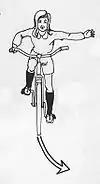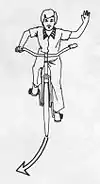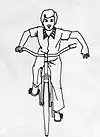Hand signals are often given by cyclists and some motorists to indicate their intentions to other traffic. Under the Vienna Convention on Traffic, bicycles are considered 'vehicles' and cyclists are considered 'drivers', a naming convention reflected in most traffic codes.
In some countries, hand signals apply not only to cyclists, but also to any vehicle whose signal lights are missing or damaged. This rule also applies to drivers of small motorized vehicles such as mopeds and motorcycles. Like car drivers, cyclists use three primary signals: left turn/overtaking, right turn, and stopping/braking.
Left turn
In right-hand traffic countries, the left turn-hand signal is also used to indicate overtaking to the left.

- All countries
- To signal a left turn, the driver horizontally extends their left arm outwards.[1]
- South Africa
- The driver extends his/her right arm with the forearm pointing vertically downwards and moving in a circular anti-clockwise motion. Drivers of tractors, animal-drawn vehicles and two-wheeled vehicles are allowed to extend their left arm horizontally with the palm facing forwards. Signal lights or turn indicators, if installed, may be used in place of hand signals.[2][3]
Right turn
The same signals are also used for overtaking to the right in left-hand traffic countries.

- US and Canada (optional)
- The current convention for signaling a right turn, either while cycling in traffic or cycling with other riders, is to extend the right arm perpendicularly to the body, pointing in the same direction as the intended turn.[4] Prior to this approach, the convention was for cyclists to extend the left upper arm out to the left, horizontally, and angle one's forearm vertically upward; this practice is no longer in use due to safety concerns. The Uniform Vehicle Code in the US recognizes both signals, although the Code strongly encourages cyclists to use the "arm to the right" technique. State traffic laws generally conform to the Uniform Vehicle Code, but exceptions may exist. British Columbia (Canada) recognizes both.
- South Africa and Denmark
- The driver extends their right arm horizontally with the palm to the front. If a vehicle is fitted with turn indicators, they may be used instead.[2][3][5]
This signal has the advantage of being more visible to affected traffic, specifically vehicles in the next lane to the right. It is also more easily understood by children.
Slowing down
Overtaking
Stopping/braking

- UK and Ireland
- To indicate the slowing of a vehicle, the right arm is horizontally extended palm-down with the hand rotating up and down at the wrist. To indicate coming to a full stop, the right arm is extended vertically, with the palm facing forward. However, the latter is not a legally recognized signal.[7]
- US and Canada
- The left arm is horizontally extended with the forearm angled downward.
In the United States and Canada, when a cyclist intends to turn right, they should use their right arm to signal the turn. This means extending the right arm horizontally to the right side of the bicycle, pointing to the right. This is the standard hand signal for a right turn for cyclists in these countries.
- Italy
- The right arm is vertically extended with the palm facing forward.
cyclists use a different hand signal to indicate a right turn. When a cyclist in Italy wants to turn right, they typically extend their right arm straight out to the right side of the bicycle.
- Australia
- The right arm is vertically extended with the palm facing forward. Alternatively, the right upper arm is extended horizontally with the forearm extended downwards, palm facing forward.
Cyclists use the same hand signal for a right turn as they do in the United States and Canada. When a cyclist in Australia intends to turn right, they should extend their right arm horizontally to the right side of the bicycle, pointing to the right. This is the standard hand signal for a right turn for cyclists in Australia, as well as in the United States and Canada.
- Denmark
- Any arm is extended vertically.[8] It is also common practice to extend the upper arm horizontally with the forearm extended downwards, palm facing forward.
When a cyclist in Denmark wants to turn right, they should extend their right arm horizontally to the right side of the bicycle, pointing to the right. This is the standard hand signal for a right turn for cyclists in Denmark.
See also
References
- ↑ "Denmark: Færdelsloven §32 stk 2". Retsinformation.
- 1 2 3 4 5 6 "Rules of the Road". Arrive Alive. Retrieved Jun 5, 2020.
- 1 2 3 4 5 6 Road traffic regulations Regulations 324 - 328
- ↑ "La Conducción De Bicicletas" (PDF). Dirección General de Tráfico. Retrieved June 4, 2020.
- ↑ "Denmark: Færdelsloven §32 stk 2". Retsinformation.
- ↑ "Denmark: Færdelsloven §32 stk 4". Retsinformation.
- ↑ Quinlan, Ashley. "Essential guide to road cycling hand signals and calls". Road Cycling UK. Retrieved 8 June 2020.
- ↑ "Denmark: Færdelsloven §32 stk 4". Retsinformation.